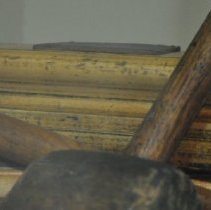Object Record
Images

Metadata
Object ID # |
2005.032.006 |
Object Name |
Planer, Printer's |
Other Name |
Planer, Proof |
Title |
Proof Planer Tool |
Lexicon category |
6: T&E For Communication |
Date |
20th-century |
Year Range from |
1929 |
Year Range to |
1970 |
Artist |
The Hamilton Mfg. Co., Wisconsin |
Made |
Hamilton Manufacturing Co. |
Place of Origin |
Wisconsin, United States of America |
Description |
Printer's proof planer tool (would be used with a printer's mallet). It is a hardwood, block-like item that has a leather piece nailed on top to help muffle the sound of the mallet blows when the printer's mallet hits the planer. The maker's name is impress-stamped in one end (The Hamilton Manufacturing Co., Wisconsin, U.S.A.). No owner's name seen on it (sometimes printers would mark their tools). Proof planers were made out of rock maple in the 1920s. |
Makers mark |
The maker's name is impress-stamped in one end "The Hamilton Manufacturing Co., Wisconsin, U.S.A.". |
Provenance |
Manufactured by The Hamilton Manufacturing Co. of Wisconsin and would have been used when letterpress printing was still prevalent. Was used and owned by Dick Knight, a retired printer, who formerly operated The Knight Press at Meaford, Grey County, which was in operation from 1929 to 1990. The Knight Press was started by his father, _______ Knight. |
Collection |
Printing & Bindery Equipment, 20th-c Collection |
Material |
Wood/Leather |
Dimensions |
H-6.5 W-8.2 L-20.3 cm |
Found |
Meaford, Municipality of Meaford, Grey County |
People |
Knight, Dick |
Subjects |
Printing Industry Printing Printers |
Search Terms |
The Knight Press (Meaford) |
Function |
A proof planer is used in conjunction with a printer's mallet (usually made of hickory) during a pre-press task of letterpress printing work . A planer was placed over type that was set in a form in a chase on a perfectly-flat imposing stone (sometimes called a composing stone), that would be supported on an imposing table. The planer was hit repeatedly with the mallet so that the type pieces below it were planed down (were all at the same height). If a piece of type was not at the same height as the others, it received more pressure during printing and therefore wore out faster. A printer did not want to have "weak type". Also, a higher piece of type might puncture the paper or produce a too-dark impression. |

